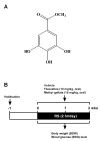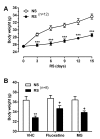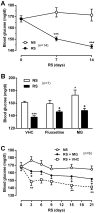Anti-Depressant Like Effect of Methyl Gallate Isolated from Acer barbinerve in Mice
- PMID: 24227946
- PMCID: PMC3823958
- DOI: 10.4196/kjpp.2013.17.5.441
Anti-Depressant Like Effect of Methyl Gallate Isolated from Acer barbinerve in Mice
Abstract
In the present study, the anti-depressant like effect of methyl gallate (MG) isolated from the stem bark of Acer barbinerve was examined in ICR mice. Body weight (BDW) and blood glucose (BDG) levels significantly decreased in the repeated restraint stress (RRS) group (2 h/day for 14 days) compared to the no stress (NS) group. To examine the effect of MG on RS-induced BDW loss and hypoglycemia, MG (10 mg/kg) and the anti-depressant fluoxetine (10 mg/kg) were administered daily for 14 days. Orally administered MG and fluoxetine significantly attenuated the RS-induced BDW loss and hypoglycemia. Interestingly, MG administered mice showed increased BDG levels in the normal and glucose feeding condition. Chronic RS-subjected mice showed immobilized and depressed behaviors. The effect of MG on the depressed behaviors was evaluated using the tail-suspension test (TST) and the forced swimming test (FST). In both tests, RS-induced immobilized behaviors were significantly reversed in MG and fluoxetine administered groups. Taken together, MG significantly attenuated the RS-induced BDW loss, hypoglycemia, and depressed behaviors. Considering that decreased BDG levels (hypoglycemia) can cause depression, MG may exert its anti-depressant like effect by preventing hypoglycemia. Our results suggest that MG isolated from A. barbinerve can exert anti-depressant like effect, and could be used as a new and natural anti-depressant therapy.
Keywords: Acer barbinerve; Anti-depressant; Hypoglycemia; Methyl gallate; Restraint stress.
Figures





Similar articles
-
Anti-depressant activity of Erythrina variegata bark extract and regulation of monoamine oxidase activities in mice.J Ethnopharmacol. 2020 Feb 10;248:112280. doi: 10.1016/j.jep.2019.112280. Epub 2019 Oct 7. J Ethnopharmacol. 2020. PMID: 31600560
-
Methyl gallate from Acer barbinerve decreases melanin synthesis in Mel-Ab cells.Pharmazie. 2015 Jan;70(1):55-9. Pharmazie. 2015. PMID: 25975099
-
Anti-depressant effect of hesperidin in diabetic rats.Can J Physiol Pharmacol. 2014 Nov;92(11):945-52. doi: 10.1139/cjpp-2014-0281. Epub 2014 Sep 19. Can J Physiol Pharmacol. 2014. PMID: 25358020
-
Fluoxetine reverses the behavioral despair induced by neurogenic stress in mice: role of N-methyl-d-aspartate and opioid receptors.Can J Physiol Pharmacol. 2016 Jun;94(6):599-612. doi: 10.1139/cjpp-2015-0429. Epub 2016 Jan 14. Can J Physiol Pharmacol. 2016. PMID: 27010380
-
Phytochemistry and pharmacology of anti-depressant medicinal plants: A review.Biomed Pharmacother. 2018 Aug;104:343-365. doi: 10.1016/j.biopha.2018.05.044. Epub 2018 May 25. Biomed Pharmacother. 2018. PMID: 29778018 Review.
Cited by
-
Atypical Antidepressant Activity of 3,4-Bis(3,4-Dimethoxyphenyl) Furan-2,5-Dione Isolated from Heart Wood of Cedrus deodara, in Rodents.Korean J Physiol Pharmacol. 2014 Oct;18(5):365-9. doi: 10.4196/kjpp.2014.18.5.365. Epub 2014 Oct 17. Korean J Physiol Pharmacol. 2014. PMID: 25352754 Free PMC article.
-
Chronic non-social stress affects depressive behaviors but not anxiety in mice.Korean J Physiol Pharmacol. 2014 Jun;18(3):263-8. doi: 10.4196/kjpp.2014.18.3.263. Epub 2014 Jun 12. Korean J Physiol Pharmacol. 2014. PMID: 24976767 Free PMC article.
-
Anti-depressant and anxiolytic potential of Acacia hydaspica R. Parker aerial parts extract: Modulation of brain antioxidant enzyme status.BMC Complement Altern Med. 2017 Apr 24;17(1):228. doi: 10.1186/s12906-017-1671-x. BMC Complement Altern Med. 2017. PMID: 28438149 Free PMC article.
References
-
- Alkadhi KA. Chronic psychosocial stress exposes Alzheimer's disease phenotype in a novel at-risk model. Front Biosci (Elite Ed) 2012;4:214–229. - PubMed
-
- Cyr NE, Earle K, Tam C, Romero LM. The effect of chronic psychological stress on corticosterone, plasma metabolites, and immune responsiveness in European starlings. Gen Comp Endocrinol. 2007;154:59–66. - PubMed
-
- Schmidt MV, Sterlemann V, Müller MB. Chronic stress and individual vulnerability. Ann N Y Acad Sci. 2008;1148:174–183. - PubMed
-
- Pittenger C, Duman RS. Stress, depression, and neuroplasticity: a convergence of mechanisms. Neuropsychopharmacology. 2008;33:88–109. - PubMed
-
- Berton O, McClung CA, Dileone RJ, Krishnan V, Renthal W, Russo SJ, Graham D, Tsankova NM, Bolanos CA, Rios M, Monteggia LM, Self DW, Nestler EJ. Essential role of BDNF in the mesolimbic dopamine pathway in social defeat stress. Science. 2006;311:864–868. - PubMed
LinkOut - more resources
Full Text Sources
Other Literature Sources
Miscellaneous

